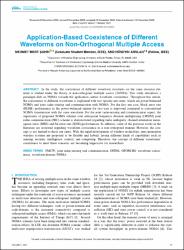| dc.contributor.author | Şahin, Mehmet Mert | |
| dc.contributor.author | Arslan, Hüseyin | |
| dc.date.accessioned | 2021-08-19T07:32:50Z | |
| dc.date.available | 2021-08-19T07:32:50Z | |
| dc.date.issued | 2021 | en_US |
| dc.identifier.citation | Şahin, M. M. ve Arslan, H. (2021). Application-based coexistence of different waveforms on non-orthogonal multiple access. IEEE Open Journal of the Communications Society, 2, 67-79. https://dx.doi.org/10.1109/OJCOMS.2020.3044680 | en_US |
| dc.identifier.issn | 2644-125X | |
| dc.identifier.uri | https://dx.doi.org/10.1109/OJCOMS.2020.3044680 | |
| dc.identifier.uri | https://hdl.handle.net/20.500.12511/7871 | |
| dc.description.abstract | In the study, the coexistence of different waveform structures on the same resource element is studied under the theory of non-orthogonal multiple access (NOMA). This study introduces a paradigm-shift on NOMA towards the application-centric waveform coexistence. Throughout this article, the coexistence of different waveforms is explained with two specific use cases, which are power-balanced NOMA and joint radar-sensing and communication with NOMA. For the first use case, block error rate (BLER) performance in the power-balanced regime for two user is improved compared to conventional NOMA transmission with the same waveform. For the joint radar-sensing and communication aspect, the superiority of proposed NOMA scheme over orthogonal frequency division multiplexing (OFDM) joint radar-communication (JRC) scheme is demonstrated regarding radar ambiguity, channel estimation meansquare error (MSE) and bit-error rate (BER) performances. In addition, some of the previous works in the literature are reviewed regarding waveform coexistence in a non-orthogonal manner. However, the concept is not limited to these use cases. With the rapid development of wireless technology, next-generation wireless systems are proposed to be flexible and hybrid, having different kinds of capabilities such as sensing, security, intelligence, control, and computing. Therefore, the concept of different waveforms' coexistence to meet these concerns are becoming impressive for researchers. | en_US |
| dc.language.iso | eng | en_US |
| dc.publisher | IEEE-Institute of Electrical and Electronics Engineers Inc. | en_US |
| dc.rights | info:eu-repo/semantics/openAccess | en_US |
| dc.rights | Attribution 4.0 International | * |
| dc.rights.uri | https://creativecommons.org/licenses/by/4.0/ | * |
| dc.subject | FMCW | en_US |
| dc.subject | Joint Radar-Sensing and Communication | en_US |
| dc.subject | OFDM | en_US |
| dc.subject | OFDM-IM | en_US |
| dc.subject | Waveform Coexistence | en_US |
| dc.subject | Waveform-Domain NOMA | en_US |
| dc.title | Application-based coexistence of different waveforms on non-orthogonal multiple access | en_US |
| dc.type | article | en_US |
| dc.relation.ispartof | IEEE Open Journal of the Communications Society | en_US |
| dc.department | İstanbul Medipol Üniversitesi, Mühendislik ve Doğa Bilimleri Fakültesi, Elektrik ve Elektronik Mühendisliği Bölümü | en_US |
| dc.authorid | 0000-0001-9474-7372 | en_US |
| dc.identifier.volume | 2 | en_US |
| dc.identifier.startpage | 67 | en_US |
| dc.identifier.endpage | 79 | en_US |
| dc.relation.publicationcategory | Makale - Uluslararası Hakemli Dergi - Kurum Öğretim Elemanı | en_US |
| dc.identifier.doi | 10.1109/OJCOMS.2020.3044680 | en_US |



















